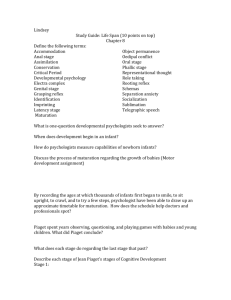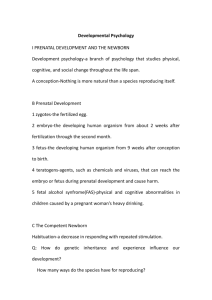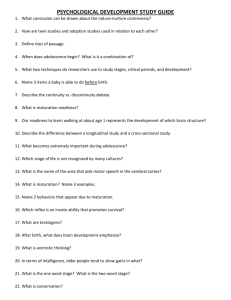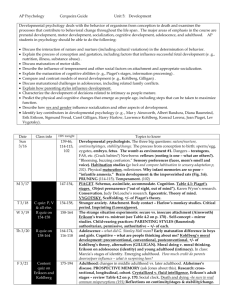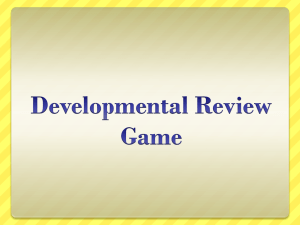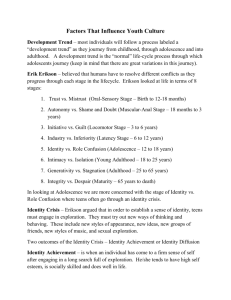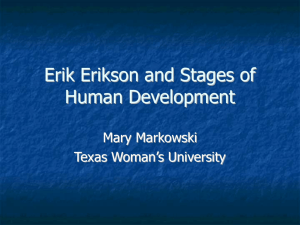Unit-_9__Review
advertisement
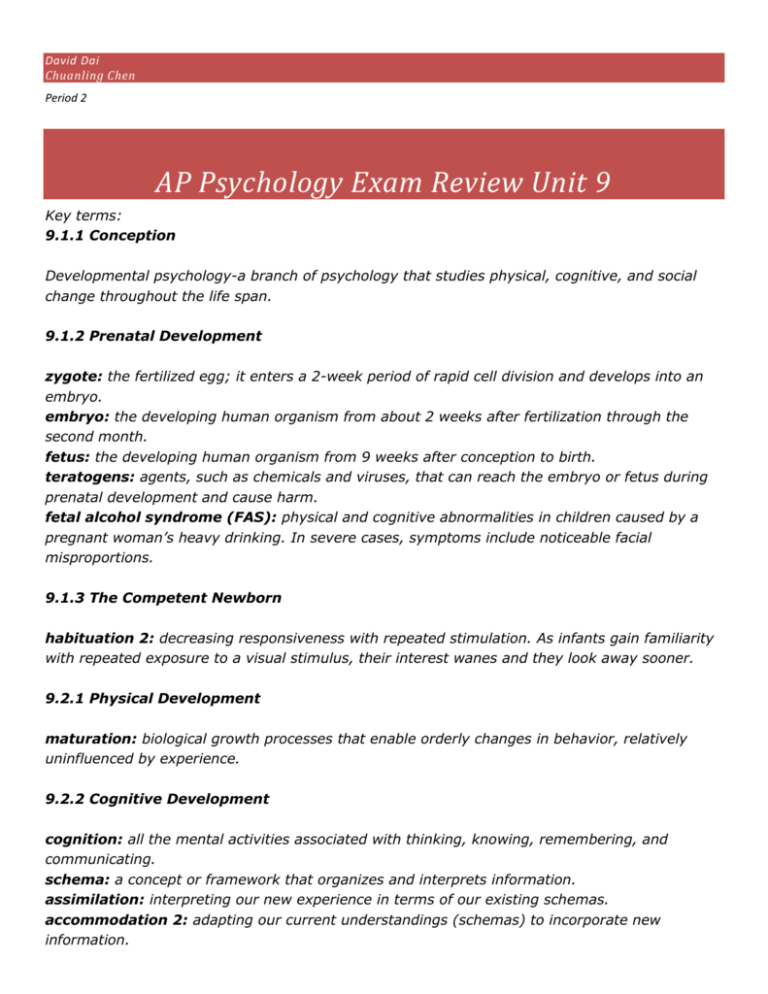
David Dai Chuanling Chen Period 2 AP Psychology Exam Review Unit 9 Key terms: 9.1.1 Conception Developmental psychology-a branch of psychology that studies physical, cognitive, and social change throughout the life span. 9.1.2 Prenatal Development zygote: the fertilized egg; it enters a 2-week period of rapid cell division and develops into an embryo. embryo: the developing human organism from about 2 weeks after fertilization through the second month. fetus: the developing human organism from 9 weeks after conception to birth. teratogens: agents, such as chemicals and viruses, that can reach the embryo or fetus during prenatal development and cause harm. fetal alcohol syndrome (FAS): physical and cognitive abnormalities in children caused by a pregnant woman’s heavy drinking. In severe cases, symptoms include noticeable facial misproportions. 9.1.3 The Competent Newborn habituation 2: decreasing responsiveness with repeated stimulation. As infants gain familiarity with repeated exposure to a visual stimulus, their interest wanes and they look away sooner. 9.2.1 Physical Development maturation: biological growth processes that enable orderly changes in behavior, relatively uninfluenced by experience. 9.2.2 Cognitive Development cognition: all the mental activities associated with thinking, knowing, remembering, and communicating. schema: a concept or framework that organizes and interprets information. assimilation: interpreting our new experience in terms of our existing schemas. accommodation 2: adapting our current understandings (schemas) to incorporate new information. sensorimotor stage: in Piaget’s theory, the stage (from birth to about 2 years of age) during which infants know the world mostly in terms of their sensory impressions and motor activities. object permanence: the awareness that things continue to exist even when not perceived. preoperational stage: in Piaget’s theory, the stage (from 2 to about 6 or 7 years of age) during which a child learns to use language but does not yet comprehend the mental operations of concrete logic. conservation: the principle (which Piaget believed to be a part of concrete operational reasoning) that properties such as mass, volume, and number remain the same despite changes in the forms of objects. egocentrism: in Piaget’s theory, the preoperational child’s difficulty taking another’s point of view. theory of mind: people’s ideas about their own and others’ mental states—about their feelings, perceptions, and thoughts, and the behaviors these might predict. concrete operational stage: in Piaget’s theory, the stage of cognitive development (from about 6 or 7 to 11 years of age) during which children gain the mental operations that enable them to think logically about concrete events. formal operational stage: in Piaget’s theory, the stage of cognitive development (normally beginning about age 12) during which people begin to think logically about abstract concepts autism: a disorder that appears in childhood and is marked by deficient communication, social interaction, and understanding of others’ states of mind. 9.2.3 Social Development stranger anxiety: the fear of strangers that infants commonly display, beginning by about 8 months of age. attachment: an emotional tie with another person; shown in young children by their seeking closeness to the caregiver and showing distress on separation. critical period: an optimal period shortly after birth when an organism’s exposure to certain stimuli or experiences produces proper development. imprinting: the process by which certain animals form attachments during a critical period very early in life. temperament: a person’s characteristic emotional reactivity and intensity. basic trust: according to Erik Erikson, a sense that the world is predictable and trustworthy; said to be formed during infancy by appropriate experiences with responsive caregivers. self-concept: all our thoughts and feelings about ourselves, in answer to the question, “Who am I?” 9.2.4 Gender Development gender: in psychology, the biologically and socially influenced characteristics by which people define male and female. aggression: physical or verbal behavior intended to hurt someone. X chromosome: the sex chromosome found in both men and women. Females have two X chromosomes; males have one. An X chromosome from each parent produces a female child. Y chromosome: the sex chromosome found only in males. When paired with an X chromosome from the mother, it produces a male child. testosterone: the most important of the male sex hormones. Both males and females have it, but the additional testosterone in males stimulates the growth of the male sex organs in the fetus and the development of the male sex characteristics during puberty. gender role: a set of expected behaviors for males or for females. role: a set of expectations (norms) about a social position, defining how those in the position ought to behave. gender role: a set of expected behaviors for males or for females. gender identity: our sense of being male or female. gender typing: the acquisition of a traditional masculine or feminine role. social learning theory: the theory that we learn social behavior by observing and imitating and by being rewarded or punished. Key People: Jean Piaget Key Experience: Figure 9.11 Object permanence Infants younger than 6 months seldom understand that things continue to exist when they are out of sight. But for this infant, out of sight is definitely not out of mind. Doug Goodman Testing children’s theory of mind This simple problem illustrates how researchers explore children’s presumptions about others’ mental states. Connection with other Units: Unit 9 is related with unit 6, because the people were develop what they learned. Visual: Stranger anxiety A newly emerging ability to evaluate people as unfamiliar and possibly threatening helps protect babies 8 months and older. Memory Trick: http://psychology.about.com/library/quiz/bl_dev_quiz.htm G. Stanley Hall (1904), one of the first psychologists to describe adolescence, believed that this tension between biological maturity and social dependence creates a period of “storm and stress.” adolescence: the transition period from childhood to adulthood, extending from puberty to independence puberty: the period of sexual maturation, during which a person becomes capable of reproducing. primary sex characteristics: the body structures (ovaries, testes, and external genitalia) that make sexual reproduction possible. secondary sex characteristics: nonreproductive sexual characteristics, such as female breasts and hips, male voice quality, and body hair. Menarche:the first menstrual period Preconventional morality Before age 9, most children’s morality focuses on self-interest: They obey rules either to avoid punishment or to gain concrete rewards Conventional morality By early adolescence, morality focuses on caring for others and on upholding laws and social rules, simply because they are the laws and rules. Postconventional morality With the abstract reasoning of formal operational thought, people may reach a third moral level. Actions are judged “right” because they flow from people’s rights or from self-defined, basic ethical principles. Theorist Erik Erikson (1963) contended that each stage of life has its own psychosocial task, a crisis that needs resolution. identity: our sense of self; according to Erikson, the adolescent’s task is to solidify a sense of self by testing and integrating various roles. social identity: the “we” aspect of our self-concept; the part of our answer to “Who am I?” that comes from our group memberships intimacy: in Erikson’s theory, the ability to form close, loving relationships; a primary developmental task in late adolescence and early adulthood. emerging adulthood: for some people in modern cultures, a period from the late teens to mid-twenties, bridging the gap between adolescent dependence and full independence and responsible adulthood. emerging adulthood: for some people in modern cultures, a period from the late teens to mid-twenties, bridging the gap between adolescent dependence and full independence and responsible adulthood. menopause: the time of natural cessation of menstruation; also refers to the biological changes a woman experiences as her ability to reproduce declines. Sensory Abilities /Health Dementia and Alzheimer’s Disease Aging and Memory Aging and Intelligence Phase I: Cross-Sectional Evidence for Intellectual Decline In cross-sectional studies, researchers at one point in time test and compare people of various ages. When giving intelligence tests to representative samples of people, researchers consistently find that older adults give fewer correct answers than do younger adults Phase II: Longitudinal Evidence for Intellectual Stability longitudinal study: research in which the same people are restudied and retested over a long period Phase III: It All Depends With “everyone knowing” two different and opposing facts about age and intelligence, something was clearly wrong. Research is further complicated by the finding that intelligence is not a single trait, but rather several distinct abilities (Unit 11). crystallized intelligence: our accumulated knowledge and verbal skills; tends to increase with age fluid intelligence: our ability to reason speedily and abstractly; tends to decrease during late adulthood social clock: the culturally preferred timing of social events such as marriage, parenthood, and retirement. three pervasive issues: (1) how development is steered by genes and by experience, (2) whether development is a gradual, continuous process or a series of discrete stages, and (3) whether development is characterized more by stability over time or by change. We have considered the first issue in Unit 1 and Unit 3C Studies of the inheritance of temperament, and of twins and adopted children (in Unit 3C), confirm that nature and nurture influence development. Genes and environment, biological and social factors direct our life courses, and their effects intertwine A Very nice link about human develop: http://www.youtube.com/watch?v=BJFi9EBLjW8

